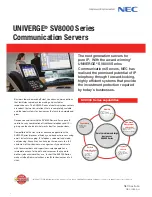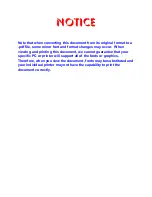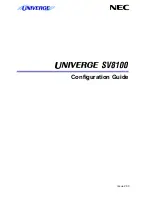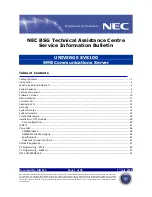
Issue 2.0
10-14
SV9100 NetLink
A DSP is used on the system GCD-CP10 which has the call. For instance, when
a trunk on System ID 2 uses a receiver, a DSP on System ID 2 is used.
The Primary System must control DSP resources on the Secondary Systems
but it cannot control all of them.
There are five zones to handle DSP resources in NetLink. The zone number
depends on the System ID number.
In the same Zone, the communication servers must share the DSP resource
number. For instance, if a user in System ID-1 is using DSP resource #1,
resource #1 becomes busy in Zone #1 (System ID 1, 6, 11, 16, 21, 26, 31, 36,
41, 46).
All communication servers follow the DSP Setting in Program 10-09 in the
Primary System.
3.4 E911
A trunk is required for each communication server for 911 calls and the ARS
routing table must be set up to seize the proper trunk. If no DSP resource is
available, one of the active DSPs is dropped and the communication server uses
that DSP for the 911 call.
3.5 Music on Hold
When External MOH is assigned, the AUX1 or AUX2 on the front of the
GCD-CP10 can only be utilized at the Primary Site. All Secondary sites must
provide the External MOH input via an ACI Input [ PGD(2)-U10 ADP].
Both the Primary Site and Secondary Sites can have their own MOH source
connected to the CN8 or CN9 on the front of the GCD-CP10. Same rules below
apply.
If the external MOH setting is defined in the Primary System, each
communication server needs to have an external MOH source.
Zone #
System ID
1
1, 6, 11, 16, 21, 26, 31, 36, 41, 46
2
2, 7, 12, 17, 22, 27, 32, 37, 42, 47
3
3, 8, 13, 18, 23, 28, 33, 38, 43, 48
4
4, 9, 14, 19, 24, 29, 34, 39, 44, 49
5
5, 10, 15, 20, 25, 30, 35, 40, 45, 50
Summary of Contents for Univerge SV9100
Page 1: ...Networking Manual A50 035910 004 AU Issue 2 0...
Page 20: ...xviii Table of Contents Issue 2 0...
Page 26: ...xxiv List of Figures Issue 2 0...
Page 33: ...Book 1 SV9100 K CCIS...
Page 49: ...Issue 2 0 1 16 General Information US Only Figure 1 15 Circuit Identification Codes CIC...
Page 53: ...Issue 2 0 1 20 General Information US Only...
Page 61: ...Issue 2 0 2 8 Hardware Installation US Only...
Page 195: ...Issue 2 0 4 116 Features and Specifications...
Page 242: ...Book 2 SV9100 IP Networking...
Page 256: ...Issue 2 0 2 12 IP Networking...
Page 312: ...Issue 2 0 4 48 Programming...
Page 376: ...Issue 2 0 6 30 SIP Trunking...
Page 391: ...Issue 2 0 7 14 H 323 Trunking...
Page 467: ...Issue 2 0 8 76 IP Multiline Station SIP...
Page 551: ...Issue 2 0 10 64 SV9100 NetLink Conditions None Feature Cross Reference None...
Page 567: ...Issue 2 0 10 80 SV9100 NetLink Conditions None Feature Cross Reference None...
Page 579: ...Issue 2 0 11 6 NAPT...
Page 580: ...Issue 2 0 SV9100 Networking Manual 11 7...
Page 581: ...Issue 2 0 11 8 NAPT...
Page 582: ...Issue 2 0 SV9100 Networking Manual 11 9...
Page 583: ...Issue 2 0 11 10 NAPT...
Page 584: ...Issue 2 0 SV9100 Networking Manual 11 11...
Page 595: ...Issue 2 0 12 4 All DSP Busy Indication...
Page 671: ...Issue 2 0 13 76 AspireNet Conditions None Feature Cross Reference None...
Page 685: ...Issue 2 0 13 90 AspireNet Department Calling Flexible System Numbering Intercom...
Page 707: ...Issue 2 0 13 112 AspireNet Default Trunk Port Number Name 1 Line 001 2 Line 002 400 Line 400...
Page 713: ...Issue 2 0 13 118 AspireNet Department Calling...
Page 765: ...Issue 2 0 13 170 AspireNet...
















































